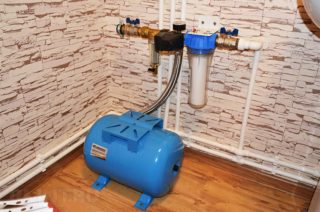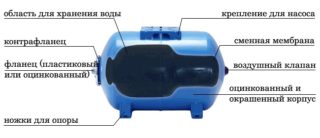The hydraulic accumulator is part of the autonomous water supply system. It is installed to maintain the set pressure, compensate for water hammer, and prevent wear of the pump motor. The device has a simple design, therefore, maintenance and repair of the accumulator in the water supply system can be performed independently.
Features of servicing the accumulator

Automation of the water supply system prolongs the service life of the pumps, allows maintaining a constant pressure in the pipeline. The role of the drive is assigned to the hydraulic accumulator. Inside the sealed steel tank is air and a rubber membrane into which water is pumped. The fluid pressure in the system is controlled by a relay installed at the inlet to the tank. For the correct operation of the network, it is necessary to ensure a stable air pressure in the tank. The rarefaction of the environment leads to an imbalance in the water supply.
The equipment requires maintenance. The operating instructions for the device indicate the frequency of checking the operating pressure. It is 1 time per 3-6 months. Extra service is required when the pump starts and stops increasing. You will need an electronic or automotive pressure gauge to check. Work is carried out after draining the water from the tank.
In the upper part of the body there is a protective cover, under which the nipple is located. A pressure gauge is connected to the spool to indicate the air pressure. The optimal parameter is indicated in the product passport. The lower threshold for switching on the pump is also taken into account. The pressure in the air chamber should be less than 10%. If the measured pressure is lower than the recommended one, it is necessary to pump it up with a compressor.
Equipment maintenance includes:
- The tank body is inspected every 6 months. The presence of dents, metal corrosion, drips is established. If any of the listed damage is found, the cause of the problem must be determined.
- Every month, the parameters for turning on and off the pump are checked. Lost settings are controlled by pressure switch springs.
- The integrity of the rubber membrane is established every six months. An indicator of the problem is the flow of water from the air nipple.
Laying the accumulator for long-term storage in an inoperative state occurs after the liquid is completely drained. The tank is left in a dry place.
The main malfunctions of the device
Stable operation of the hydraulic accumulator assemblies ensures comfortable use of plumbing fixtures. Uneven water flow from the tap is a sign of equipment problems. The liquid flows in jerks, the vibration of the pipes is felt. An indicator of a malfunction is the frequent activation of the pressure switch. The main types of breakdowns during the operation of the hydraulic tank:
- water flow at the flange or nipple attachment point;
- drop in air pressure in the tank;
- the water pressure does not increase while the pump is running;
- frequent repetition of the pump on / off mode.
Experts advise doing a complete prophylaxis with disassembling the accumulator after three years of operation. The procedure is needed for the planned replacement of worn parts. It will prevent breakdowns and emergencies that occur unexpectedly.
How to find and fix a breakdown

To find the fault yourself, you need to know the structure of the hydraulic accumulator. Parts of its construction:
- metal case;
- rubber membrane;
- flange with outlet for water supply;
- air injection nipple;
- installation platform.
A simple device ensures long-term operation of equipment and rare breakdowns. Incorrect operating mode settings become their main cause. Troubleshooting is carried out by characteristic signs. Having found the cause of the breakdown, they fix it on their own or invite a specialist.
Frequent activation of the pump causes several factors:
- Low air pressure in the tank. Eliminated by pumping the compressor through the nipple.
- Loss of tightness. Holes appear in the metal case due to rust or mechanical damage. Cover the container with a liquid soapy solution to check for a leak. The tightness is restored by specialists.
- A small threshold difference is set on the pressure control switch. The problem is corrected by adjusting the small spring of the device.
- Diaphragm rupture. The rubber bulb inside the tank can burst due to excessive stretching, friction against the walls of the tank, due to natural wear and tear. The breakage is corrected by replacing or repairing the membrane. Vulcanizing the rubber product restores its integrity. When replacing, you should choose an original part of the same volume.
Low water pressure:
- Insufficient pump power. Check the calculations for the correspondence between the volume of the accumulator and the characteristics of the unit.
- Leads through the non-return valve. Replace the part after shutting off the water.

Constant water pressure drop:
- Air rarefaction - should be pumped up with a compressor or pump to 1.5-2 atmospheres.
- Broken nipple. The device through which air is pumped may break. The tightness of the tank is lost. You can replace the nipple in the accumulator with your own hands or take the device to a service center. The part is secured with a nut, it is carefully unscrewed, then removed. When installing a new nipple, a rubber gasket and sealant is used.
Fluid leaks on the body:
- The flange is fluid. If the part is new, it is enough to tighten the screws with a wrench. An old, corroded flange needs to be replaced. Parts are sold in a specialist store. They are made entirely of metal or with plastic inserts.
- Leaking from the nipple. The cause of the problem is a ruptured membrane. For replacement, it is necessary to remove the flange, then remove the rubber container. It is recommended to wash the inside of the tank. The new membrane is installed after complete drying. It is secured with a flange.
Before starting any repair work, the pumping station is disconnected from the power supply. All the water is drained from the tank by opening the nearest tap. To replace parts, the accumulator is dismantled from the water supply system. During the disassembly process, prepare to remove the significant amount of water remaining inside the membrane.
Self-repair of breakdowns or calling a specialist
Repairing the accumulator tank for people who constantly deal with tools and equipment seems to be a simple matter. It takes skill and knowledge to remove the nipple and install a new part with complete tightness. Unscrewing the screws of the old flange and replacing the membrane is easier, but without a suitable wrench, this will not work. The hole in the housing can only be repaired by welding; a specialist is required for the job. It is enough for consumers to carry out regular maintenance of the hydraulic tank, and entrust complex repairs to the representatives of the service center.
In case of significant damage and wear of the accumulator assemblies, it is recommended to purchase new equipment.








